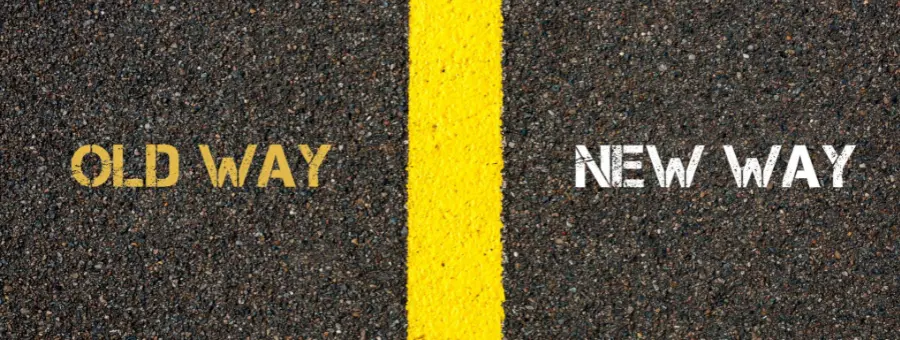
What and how we learn has changed significantly. This has major implications for organisations, teams and individuals with respect to training and development … and their performance.
Learning involves two aspects: Information and How to do things. On both fronts the world has changed dramatically. Teachers, trainers, coaches, mentors and those who they are teaching, training, coaching, mentoring had best get across the changes … or risk falling behind. Little point having a lot to offer if the messages don’t get through.
Traditional learning / teaching media (especially classroom type situations) have too often not been all that effective. .. not all of the information is relevant or interesting to recipients, sometimes a small portion of the information is retained and even less is used. Dissemination of information by telling or demonstrating how to do something as trainees simply listen or watch is not particularly effective. People retain more by doing, saying and writing, than they do by watching, reading and listening, .. and the most effective is via a combination of these. To train people well, we have to use more ‘recipient active’ methods.
This has always been true but trainers and educators have too often ignored this. When was the last time you bought something and read the Instruction Manual to learn how to use it? Sure, we still do that sometimes but, more and more, we learn to operate things by doing … by trial and error. Watch a young person take possession of something new … they don’t ask for an Instruction Manual .. they start ‘playing’ with it (many operational things now don’t even come with Instruction Manuals!). If you have young children, watch how amazingly quickly they teach themselves how to use smart phones, tablets, game boys, etc. We learn quickly by doing!
To state the bleeding obvious, we learn a lot more often now via the internet. There are two aspects here. First, we (can) initiate more of our own learning, and second, the internet is a massive resource for our learning. Both of these aspects enable earlier, broader, cheaper (money and time) and more convenient learning, for those who choose it. Combined, these factors downgrade the importance of some of the more traditional forms of learning, and this is affecting suppliers of learning, receivers of learning and the pool of people involved. To what degree has your organisation engaged these more freely available learning media? If you’re still hearing statements like ‘I need to be trained in spreadsheets, database use, etc.’ …. that doesn’t say a lot about the training capability and culture that exists within your organisation. That type of training should be self conducted (online) and surely now it’s the responsibility of the individual not the organisation to engage such basic training. Organisations now have the opportunity to be much higher level in the training they provide .. and that’s really exciting!
We are now learning significantly more from video. At the time of writing here are some statistics about YouTube: More than 1 billion unique users visit YouTube each month, over 6 billion hours of video are watched each month on YouTube, 100 hours of video are uploaded to YouTube every minute, millions of subscriptions happen each day, the number of people subscribing daily is up more than 3x since last year and …. there are 216 million “How To” video’s on YouTube. Statistics are showing that younger people are using internet video searches more often than they search for written information .. they search YouTube more often than they search via Google! Two aspects again here … initiated self learning and learning from video watching rather than reading.
Technology is facilitating higher level training … for business and sports people. To run role plays in business we used to have to hire a video camera; now we use one of the many smartphones or tablets in the room for the session … no cost, crystal clear and instant playback. We can now cover in minutes what was either too costly, too slow to get the replay, or unclear. We can video an athlete in action and watch it back with them in an instant, even in slo-mo, to detect flaws and work to remedy them immediately. Organisations should be making the most of such technology, frequently, and be proactive in sourcing the latest as it becomes available. Video’d role plays in business should be an integral part of performance improvement, especially with respect to communication, negotiation and presentation skills. The fact that the video creates even more pressure on the people involved is a good thing .. it’s getting closer to the real situations they will have to perform in .. rather than just doing role plays for colleagues to give feedback on without the participants being able to see themselves. Have you ever experienced the power of watching your own performance in replay? I have and I cringe at the mistakes, but boy it forces me to learn more quickly!
As earlier, learning is becoming more aligned with the initiative of the individual and the team, and not just the responsibility of the organisation. I reckon that’s a great thing. Too many SME’s in business have been unable to provide high level training to their own people. It also brings initiative into play for those prepared to go there. It’s also a great selection tool for new personnel .. “What self initiated training / learning have you engaged in the last three months?”
This might seem a strange thing to say but there are now a lot of things we don’t have to learn … because they are so easy to find if we need them, via the internet. It’s similar to why open book exams came into play years ago … because of the importance of one’s ability to source and apply information rather than being able to remember it all .. being resourceful. But now it’s gone way past that … you don’t have to know where to source information … it’s (all) on the internet! And this creates a secondary issue … it’s very important to know how to apply what’s learned! It’s often a criticism I hear of Gen Y’s … they’re great at sourcing information but lack the ability to apply it .. so what are we doing about that, if it’s true? And the training of Gen Y’s has to have some focus on their face to face and oral communication skills because a significant portion of their learning comes from impersonal sources that don’t help the development of interpersonal skills as they learn. (Don’t be offended Gen Y’s .. you’re magnificent at I.T., sourcing information and a host of other aspects of life!). Resourcefulness is obviously an important quality to look for when selecting people into an organisation, but that’s little good without the ability to apply information and problem solve .. and this is even more important now because information is so readily available to everyone. So test for these abilities, practically, when selecting new people.
When we learn has changed dramatically … one in two people in Australia are now also on the internet while watching television and this is increasing. Sure, some of the internet engagement during those times is social media but not always .. sometimes its genuine curiosity for information. We now have the capability (and inclination, I think) to learn more frequently, more broadly, about things that interest us … because we can. The internet and television are rapidly becoming one and the same. Think that through in terms of our learning engagements, good and bad!
Who we learn from is much broader now … for those of us who choose to! Thought Leaders forums, philosophers of the past, how today’s entrepreneurs think and what they think, the myriad of information on the lives of the world’s most successful people, etc. … all now at our fingertips, 24/7 . Isn’t that fantastic! There is virtually nothing we can’t source from the world’s best and about the world’s best, whenever we want.
We can now learn in smaller pieces and more frequently. The impact of this is the content is much more likely to be retained and therefore possibly ‘used’ in future. This was always part of high level learning and training of the past but can now be facilitated with ease. And our learning now takes less time (online, webinars .. we don’t have to ‘go’ to institutions) so we can do more of it.
I’m not sure what all of the above says about ‘bricks and mortar’ training / education institutions … they clearly retain importance but common sense suggests they need to adapt to the myriad of changes that are going on, so fast … they are surrounded by more alternatives now. Many / most of these institutions are changing the ways they go about ‘teaching’.
Is it becoming a problem that we have so much information available to us and coming at us? Is it information overload? Is it stymying people’s actions? Is it overwhelming? That’s all up to the individual. Everyone has to take control of their learning and ensure that the balance between intake and behavioural adaptations is effective .. and not just be sponges to soak it all up. There’s not much point in learning if it leads to little action.
A slightly different point … Our phones are not just phones anymore; they are broadly capable devices. They house our email, calendar, provide internet capability, radio, gps, time, weather, gambling, etc. Imagine what they will do and provide to us in two years time !! I reckon they will link to and help facilitate many things in our lives … television, car, air conditioning, security systems, etc. And the device itself may be something different to what it looks like now .. it may be the google glasses that are already available … or whatever. And so much more of our learning will come from these devices .. so get ready and be frontfoot with this. We are now being influenced (taught) by more sources (people and organisations) and more often … so we are either accidentally or deliberately engaging that learning. It needs to have some conscious design from the individual as to the intake .. content, frequency and actions therefrom.
Upskilling (as distinct from knowledge growth) from non personal sources (such as online courses and devices) can generate less feedback to individuals on how they are progressing … whereas the more traditional sources (i.e. from other people) have provided that feedback. So, it’s important to ensure appropriate feedback is being received. Further, with so much of our learning now coming from non personal sources (which will grow), the experience we now receive just in human interaction is dropping, and this can have negative implications for our skills in this area, as mentioned for Gen Y’s.
Positively, those who can teach and train has opened right up, because of the ease of accessing information and the “How To’s”, and the ability of supplying those to an audience. We can place videos onto YouTube, and we can give advice / provide information to a wider audience via Blogs, websites, etc., whenever we want. Virtually anyone can be a teacher, adviser or a trainer .. you don’t have to have a qualification (or even experience) anymore … that’s significant and it’s positive, providing it’s done accurately and effectively. People have forged careers, started businesses and created solid incomes by taking this opportunity.
Importantly, an organisation that predominantly supplies information to its people (especially information they can readily be sourced from the internet) is not a particularly effective trainer of its own people. Providing experiential learning and training is now more important for an organisation than ever. And sending people off to courses to just soak up information or bringing in trainers who talk at your people, is sadly lacking. It’s the experiences organisations give their people that matters more now than ever. McDonalds were applying that principle many years ago .. they don’t use the word ‘training’; they replaced it with ‘experience’.
Today’s learning is challenging some people in older age groups because they are used to being ‘trained’ or ‘fed’ information. It’s actually a bit sad to observe how some of these people are experiencing reduced learning now because they are used to reacting to what is supplied, rather than getting it themselves proactively … it can even cause them to become less relevant in some situations. The solution is not for organisations to supply them the information and the ‘How To’s’; they should create ways to get them into today’s learning sphere and techniques, so their approach changes.
The fact that younger and older people are now learning in very different ways is also widening the communication gap between the generations. I say this from my own observations in the workplace. This should be addressed by training from within to bring the learning ‘styles’ closer together. Joint learning and training is essential, with patience, to ‘fuse’ the age groups. There are fundamental generation gaps inside organisations anyway, and we should not be allowing them to widen further via different learning styles and environments for older and younger.
Webinars, whilst having been around for awhile, have had a much lower uptake than was anticipated when they first began .. but watch the future! It’s a bit like skype .. around for yonks but now being taken up a lot more widely by the business community. Video link ups, as they have become cheaper, faster, better quality and easier to access, are now gaining more prominence and these will increase rapidly in the next couple of years, in my opinion. Sure, some of these facilities are used sometimes only for meetings but they are also learning media as well.
Thought leaders stare into the future and share their thoughts, guesses and visions with others. These are learnings for people around them and we should all be accessing their thinking … because we can easily do so now. Further, brainstorming sessions are more important now than ever, because of the rate of change going on around us. All organisations should have more frequent (and pure) brainstorming sessions to engage what people have learnt and can think about, to then apply that to (guessing) the future.
I have to comment on something that consistently surprises me in so many people … how little knowledge they have outside of their own sphere of ‘expertise‘. Sure, ‘jack of all trades and master of none’ is to be avoided but having too little knowledge of other areas beyond one’s own is limiting, to say the least. I see way too many people in that situation. For example, people in sales or marketing who have little financial acumen, people in senior roles in business who have absolutely no idea about the social media (and therefore can actively resist it for their organisations and themselves), professional service providers who know little about sales and marketing, Human Resources personnel who know too little about I.T., people in one industry who know little about other industries, etc. If you’re in business, surely you would want to be at least grounded in sales, (digital) marketing, the social media, administration, operations, I.T., H.R., governance, planning, finance .. the core areas of successfully running a business. If you’re in a non business organisation, what are the areas beyond your own that you should be grounded in? The point is this … initiate your own learning to be a well grounded professional, key person or team member. And if anyone’s interested in getting promoted how could that occur if you’re not? A person who is ‘across’ various areas of expertise can more effectively oversee situations and initiate new ways, compared to someone who isn’t. We can’t be expert in all areas but we have to be aware. Again, this can come down to self initiated learning because organisations tend to provide (only) specific training and learning to individuals.
The world is a much more rapid and transient place now. Organisations, their teams and individuals will be significantly affected by how well they learn and apply those learnings. Those who are best at creating, sourcing and applying information will win. Those who provide experiential learning will win. Those who stimulate strong learning environments will win.
Previous Newsletter Articles
Business Tips
HR Information
Contact Us
1300 022 270
enquiries@myabbs.com.au






